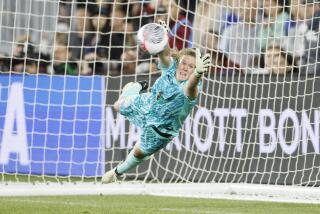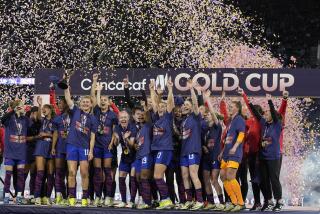SMALL TALK
- Share via
NEW YORK — Successful weight loss intrigues Americans no end. We’re all eager to hear the magic words, the secret solution to a common problem.
Which is why when Lindsay Davenport innocently told reporters at a recent tennis tournament in Southern California how she had lost nearly 30 pounds in the last three years, they laughed
“I share,” she said.
The answer says as much about Davenport’s character as it does about her weight-loss regimen. She may well be the most down-to-earth, well-rounded and grounded person on the me-first women’s tour. And, lest we forget, a caring, sharing person who happens to be one of the favorites to win the U.S. Open.
Case in point:
When Davenport finally put herself first recently, it was not a painless decision. The United States played in Spain on clay after Wimbledon in the semifinals of the Fed Cup, and Davenport looked at her hard-court schedule--four tournaments in five weeks.
She passed on the Fed Cup, going home to Newport Beach.
Billie Jean King, her mentor--and Fed Cup captain--was not thrilled. Lisa Raymond, who filled in for Davenport in singles, worried about being blamed for the subsequent loss.
But Davenport would have had to travel from Madrid to San Francisco for the first of the four tournaments and her decision not to play in Spain might have been her most important this year.
Let us count the ways:
* In Palo Alto, she defeated Steffi Graf and Venus Williams en route to the title in the Bank of the West Classic. Davenport and Natasha Zvereva also won the doubles.
* In Carlsbad, Davenport beat Monica Seles and Mary Pierce in winning the Toshiba Tennis Classic. Once again, she won the doubles with Zvereva.
* In Manhattan Beach, she defeated Seles and Martina Hingis as she won the Acura Classic.
Although her winning streak ended at three tournaments last week at New Haven, Conn., where she lost to Graf in the semifinals, Davenport established herself as the one to beat at the U.S. Open. Here, she is seeded second, behind defending champion Hingis, and is third in the WTA rankings, behind Hingis and Jana Novotna.
For Davenport, skipping the Fed Cup was clearly the correct decision. But she does not see it in such absolute terms. Before calling King, she let Seles know of her decision, wanting to make sure Seles was still planning to play.
Her reasons were legitimate--besides a heavy schedule, she had a sore arm--but the Fed Cup loss was upsetting to her even weeks later.
“In hindsight, it was a good decision, but it was a bad decision because I let the team down,” she said. “I could not go back to Europe again. It was all basically to keep my sanity.
“But I watched the [deciding] doubles and saw them lose. I was heartbroken. I felt like I let them down again.”
She now understands, however, why players put themselves first. For her, that has always been hard.
“Sometimes you think, ‘How come Pete [Sampras] never plays Davis Cup?’ ” she said. “All of a sudden, I was like, ‘That’s why he doesn’t play. It is not logistically possible.’ We wanted to win it, but at the same time I didn’t want to jeopardize my whole summer by going and doing something that can hurt me. I think [King] feels I let her down personally.”
Davenport watched a tired Seles struggle near the end of the three California tournaments and knew she’d made the right call. The summer hard-court campaign gave Davenport confidence in her ability to fight through tough stretches, knowing she could beat nearly everyone on her favorite surface.
She was faster, no longer the unwitting, flat-footed victim of the drop shot. Television commentator Tracy Austin, among others, predicted that Davenport would win the Open.
“She’s playing better than anyone on the tour right now,” Austin said. “There’s nowhere to hit to Lindsay right now. Her forehand is big. Her backhand is big. . . . Before you could get her on the run and she would make a lot of unforced errors.
“It’s whether she can stand the pressure. She keeps saying, ‘I don’t feel the pressure because the spotlight is on everybody else.’ This is her time right now to break through and I think she realizes that.”
Davenport has reached the semifinals of three Grand Slam events--the 1997 U.S. Open and the Australian and French Opens this year. Mary Carillo of CBS pointed out the difference between a normal one-week tournament and a Grand Slam event.
“She’s not yet learned how to win seven matches over two weeks,” Carillo said. “That day off [between matches] doesn’t necessarily seem to help Lindsay. She spins a little bit, and starts worrying about her next opponent or the heat or whatever. But if she’s ever had a shot, ever had a chance to win a major, this is it.”
Certainly, Davenport, who is only 22, can be somewhat reassured that Grand Slam breakthroughs are not limited to teenagers. Her former doubles partner, Novotna, for instance, won Wimbledon this year at 29.
“People are saying I can’t do it,” Davenport said. “But you never know what happens. The more times I get there, I’m feeling more comfortable. It’s a stressful situation when you are finally there.
“All the spotlight is on this one match, whereas over the last 10 days, it’s been over 69 matches. I’m getting better as a player. I don’t think my chances have slipped away.”
Two things helped Davenport in her push toward the U.S. Open. One was her intensified workout schedule, which includes 300 sit-ups a day and her sensible weight-loss plan. The other was not to read anything about herself.
It was almost easier to knock off the soda and cheese than to block out what was being written and said about her. Davenport was upset when a monthly tennis publication ripped her after she had donated money to a charity, buying a raffle ticket to win a car. Somehow, her nice gesture was turned into a cheap shot.
“I didn’t do it to win [the car],” she said. “Then I read in this magazine, ‘Oh, Lindsay didn’t win, but she’s never going to win a big one and we all know that.’ I read this and I was in shock. Nothing has ever hurt me more. I cried for half an hour. You never know if I’m going to win a big one. You can’t say that. I was only 21 at the time.”
Her decision to bypass cheese and soda was the result of a friendly wager.
“I had a bet this year that I couldn’t eat cheese or soft drinks for two months and I did it easily,” she said. “No problem. I do stuff like that for fun. During a tournament, I only drink water or maybe Gatorade. I try not to drink sodas anymore.
“I don’t drink diet or regular [soda]. I think diet is worse for you than regular. I think it’s all just crap anyway.”
As for sharing . . .
“It was a great thing for me,” she said. “It helped me a lot. A lot of times, you eat what you see on your plate. If you see less, that’s fine.
“I never really gave up anything [else]. I could have a piece of cheesecake right now if I wanted. Once you start working out, you don’t want to eat that because you know how it hurts you. Once you get into it, you see the results.”
Her hard work has resulted in her best tennis. Davenport will play Catalina Cristea of Romania today in the first round at the Open and, if form holds, could face 10th-seeded Nathalie Tauziat of France in the round of 16 and seventh-seeded Conchita Martinez in the quarterfinals.
And finally, Davenport is free of the tag “most-overlooked player” on the women’s tour. She’s still getting used to the fit.
“[Andre] Agassi captures the heart of people and [Monica] Seles does that,” she said. “I haven’t really done that. I don’t know if I ever will.”
This much is clear: Davenport does not plan on changing her affable, easygoing ways to win a Grand Slam singles title or to become No. 1.
“Everybody thinks it takes something different for them to get to the top,” she said. “I’m pretty focused on the court. But I’m not going to go around in, like, a trance for the [last] seven days of the tournament.
“I’ve been criticized a lot for that, and for a number of things. It’s just the way I am. When I lose, I might cry for 10 minutes--if it’s really close--and then I’m fine. It doesn’t affect me like I can’t eat or sleep for days.
“It’s healthy for me. I don’t want to be consumed.”
*
SMILING AGAIN
Mirjana Lucic has had a turbulent couple of months and was grateful to be back on the court at the U.S. Open. C8
More to Read
Go beyond the scoreboard
Get the latest on L.A.'s teams in the daily Sports Report newsletter.
You may occasionally receive promotional content from the Los Angeles Times.











